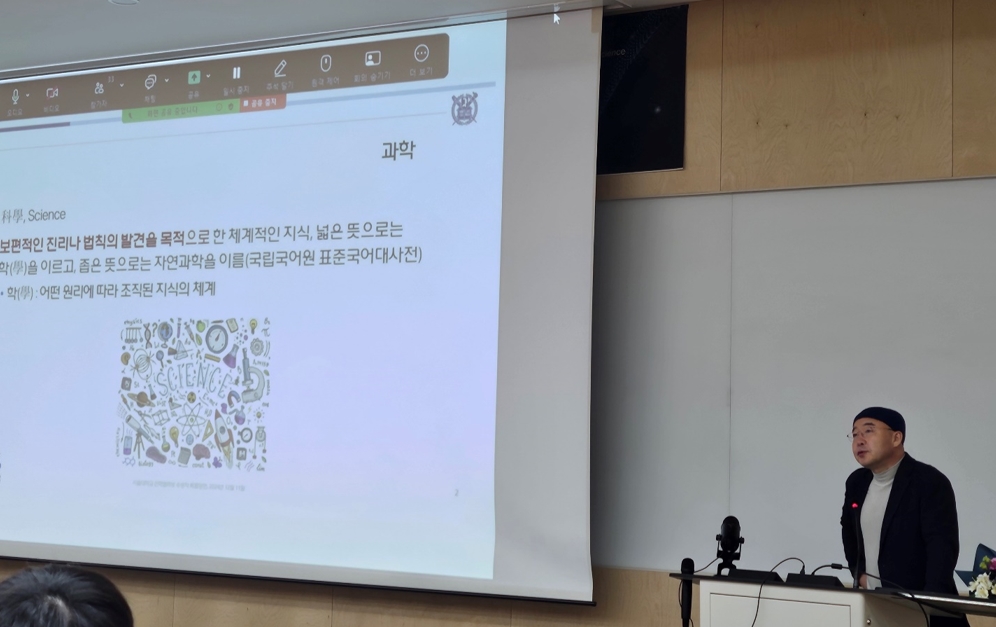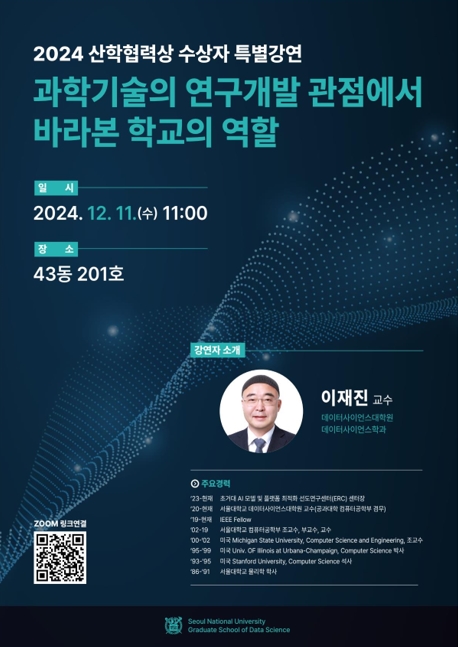Seoul National University has long been a bustling hub for research, nurturing a passionate community of students and academics who pride themselves in their fierce dedication to discovery and innovation. The university empowers its members with the necessary tools to push boundaries and redefine the frontiers of their respective fields.
In line with this vision, SNU hosted its first-ever SNU Research Day to celebrate achievements and foster an open dialogue on its ambitions for future innovation. Among the researchers recognized for their outstanding contributions, Professor Lee Jaejin (Department of Computer Science and Engineering) was one of three recipients of the SNU Industry-University Collaboration Award.
To share his wealth of insights from 24 years of research experience and professorship, he delivered a special lecture on December 11 titled Research and Development in Science and Technology: Views on the Role of Education.

Professor Lee Jaejin giving the lecture
Practical Application as a Cornerstone of University Education and R&D
Professor Lee began by acknowledging the ever-changing role of the university in today’s world. Education and research are profoundly influenced by technological advancements, economic fluctuations, political changes, environmental conditions, and cultural shifts. Therefore, at its core, university education serves a pragmatic purpose: it prepares students to navigate an uncertain future molded by these forces, ensuring that they may seamlessly adapt to the ever-evolving world.
This emphasis on adaptability and real-world impact is also reflected in the realm of research and development. The Organization for Economic Cooperation and Development (OECD) defines R&D in the following terms: “creative work undertaken on a systematic basis in order to increase the stock of human knowledge and to devise new applications based upon it.” The National Science Foundation (NSF) echoes a similar sentiment by emphasizing the broader impacts of research: “the potential to benefit society and contribute to the achievement of specific, desired societal outcomes.” In essence, researchers must answer a critical question: How does your work benefit society by addressing current global issues? These interpretations of R&D underscore the tenet of practical application as the foundation of meaningful research.
Professor Lee, through his decades of experience, is steadfast in this belief. His own work consistently aims to bridge the gap between theoretical advancements and tangible applications, tackling real-world challenges through collaboration and innovation.

Poster for Research and Development in Science and Technology: Views on the Role of Education
Convergence in Action through the Development of Chundoong
Professor Lee delved into his area of expertise in High Performance Computing (HPC), which the United States Geological Survey (USGS) defines as “the practice of aggregating computing power in a way that delivers much higher performance than one could get out of a typical desktop computer or workstation in order to solve large problems in science, engineering, or business.” The practical applications of HPC are incredibly expansive—ranging from increasing cybersecurity to mitigating the effects of climate change and designing pharmaceutical drugs—standing at the core of countless groundbreaking advancements in the 21st century.
Professor Lee traced the research and development conducted over the years by SNU’s Department of Computer Science and Engineering. A remarkable achievement by his own research group Thunder was the creation of Chundoong, a low-cost, energy-efficient heterogeneous supercomputer. Chundoong is a pioneer in many respects. It was the first supercomputer produced by an academic institution that made it to the TOP500, a list that compiles the 500 fastest non-distributed computer systems in the world. It was also the world’s earliest supercomputer with a high density of gaming Graphics Processing Units (GPUs), which are specialized hardware components that handle complex graphical and computational tasks. With a focus on cooling and software optimization technology, Chundoong was thus commercialized in 2011 by ManyCoreSoft, co-founded by members of Professor Lee’s lab. Though a product not initially developed with entrepreneurial aspirations, the CEO of ManyCoreSoft, a former student of Professor Lee, recently secured seed investment to grow the company.
In an era where convergence is celebrated as a catalyst for innovation, Chundoong stands as a prime example of the value of interdisciplinary collaboration. Merging the fields of Computer Science and Physics, it combines parallel processing in computing with the Ideal Gas Law of thermodynamics. As we know, many of the challenges that arise in our changing society are complex and cannot be solved with knowledge from a singular field. Therefore, integrating innovative ideas, approaches, and technologies from a wide range of disciplines and expertise is necessary for creating something truly novel.
Consequently, the role of university education today is to encourage students in their pursuit of interdisciplinary studies to properly cultivate specialized knowledge across different fields. Some ways to achieve this include: 1) promoting double majoring and minoring, 2) encouraging students to engage in convergent R&D under the mentorship of professors from diverse disciplines, and 3) creating entirely new academic fields that address the evolving needs of a rapidly changing world.
Professor Lee provided many valuable insights for those who attended his special lecture, linking his area of expertise in Computer Science and Engineering to the present reality of university students in the 21st century. His sage perspective, extending beyond his technical knowledge, leaves us with much to ponder regarding what we seek from our education and what it means to pursue research and development as future scholars and experts in our respective fields.
Written by Hee Seo Lee, SNU English Editor, heeseolee@snu.ac.kr

